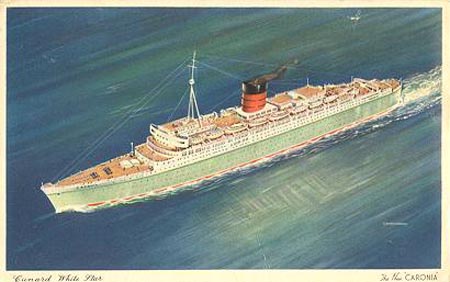Caronia

Cunard’s second Caronia was launched on 30 October 1947 by HRH Princess Elizabeth. This was the Princess’ last public engagement before she married Prince Phillip.
Caronia was Cunard’s first purpose built cruise ship, however in reality she was a dual-purpose liner, designed to undertake cruises as well as transatlantic voyages. In fact, while the Caronia was designed with cruising in mind, Cunard planned to employ her on the Atlantic during the summer months; although in reality this rarely took place.
To accommodate her cruising use, the ship’s design included many ocean liner traits, including the long bow and strong hull synonymous with transatlantic liners. However she also had a number of cruise ship traits, including out door swimming pool and an open air lido, terraced aft decks and large picture windows; all of which are design features that survive on modern cruise vessels today.
To differentiate Caronia from her fleet mates, Cunard painted her in four shades of green. As a result, she became known as the ‘Green Goddess’.
Caronia had one mast above her bridge, and the widest funnel ever to go to sea, giving her an appealing appearance and adding to her popularity.
Caronia set sail on her maiden voyage on 4 January, 1949 from Southampton bound for New York, via Cherbourg.
During the Northern winter months, Caronia made a series of extended cruises to South America and the West Indies; while in 1951 the ship completed her first world cruise. The cruise called at more than thirty ports and was hugely popular with her now loyal clientele.
Drama hit that world cruise when, during the ship’s transit of the Suez Canal she went aground near the El Ferdan bridge for an hour. Caronia suffered no long term damage and was able to make the remainder of her voyage without incident.
In 1953, Caronia undertook a voyage to Britain from America in honour of HM. Queen Elizabeth II’s coronation ceremony. American’s loved Caronia and made up the majority of her passengers throughout this period.
From 1956, Caronia commenced a series of cruises from New York to Cape Town and then returning via Japan and the Pacific Islands and Panama Canal.
During one of these voyages, on 14 April 1958 Caronia struck a light tower at the entrance to Yokohama. Caronia required urgent repairs which were undertaken at Yokosuka, a US Naval dockyard. The incident resulted in a lengthy court battle and Cunard had to pay damages.
In 1959 Caronia visited the Soviet Union calling at Yalta on the Black Sea, which was unique during the Cold War.
During the 1960’s the introduction of newer competing tonnage, including the Sagafjord, meant that Caronia was beginning to show her age. Cunard invested in refurbishing the ship’s interior, as well as rebuilding the aft lido area to make her more suitable for cruising.
However despite a full interior refit, Caronia was withdrawn from service in early 1968. The Caronia’s last voyage for Cunard was from New York to Southampton, leaving on 17 November 1957.
At the end of her final voyage, the ship was sold to Domus Turist with the intention to use the ship as a floating hotel at Dubrovnik. Due to technical issues with the ship’s machienary, the sale fell through. On 24 May 1968 it was sold to Star Shipping and renamed Columbia, sailing to Piraeus in July. Here, she was renamed, Caribia.
The intention was to use the ship for cruising and she was sent to New York for this use. She sailed on her only cruise as Caribia on 11 February 1969 however a serious mechanical fault left the vessel adrift without power. She was returned to New York and lingered here for five years.
Caribia’s final voyage was to the breakers in 1974, however on 14 August the ship broke up having collided with a breakwater off the coast of Guam.
Image source: Simplon Post Cards


